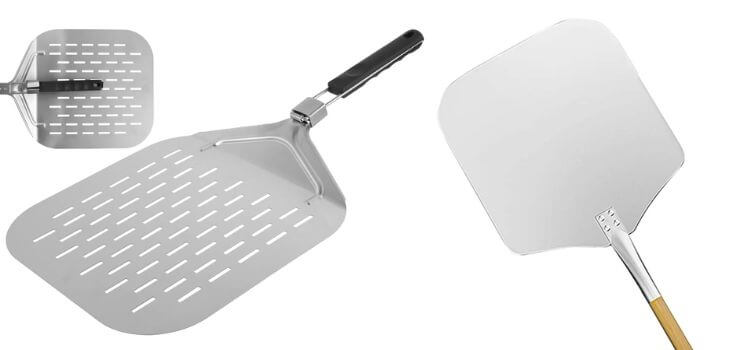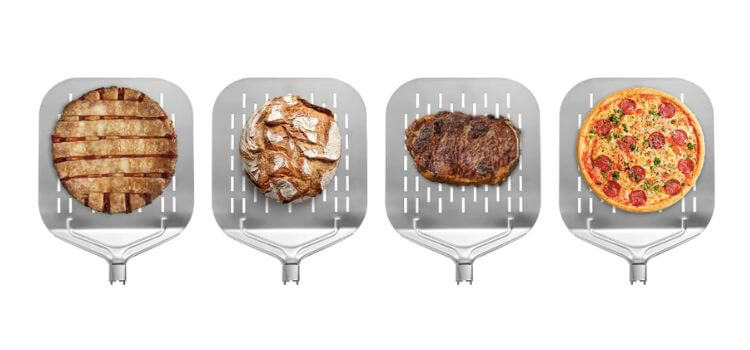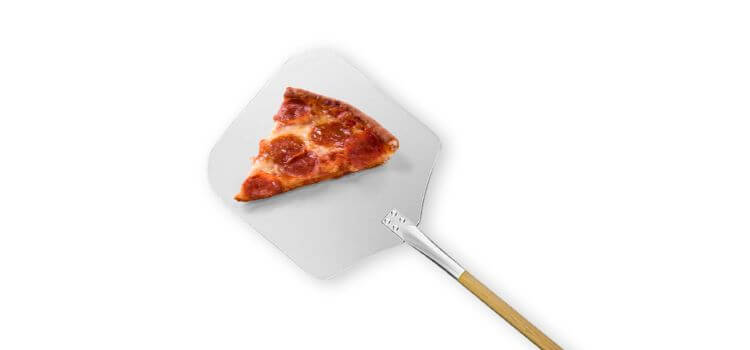As an Amazon Associate, I earn from qualifying purchases

The type of pizza peel you use can significantly affect the outcome when crafting the perfect pizza. In this article, we explore the nuanced debate between perforated and solid pizza peels, examining their distinct characteristics, benefits, and the influence each type has on the art of pizza making.
Whether you’re a seasoned pizzaiolo or a home cook looking to elevate your pizza game, understanding the nuances between these two types of peels is crucial. Join us as we uncover the secrets behind choosing the ideal pizza peel for your culinary creations.
Perforated Pizza Peel

A perforated pizza peel is a sleek, paddle-shaped instrument designed for smoothly sliding pizzas into and out of the oven. It is made from lightweight materials such as aluminium or wood and has small holes on its surface.
Benefits of using a perforated pizza peel
A significant advantage of utilizing a perforated pizza peel lies in its capacity to diminish the friction between the peel and the pizza dough. The small holes on its surface allow air to pass through, making it easier to slide the pizza in and out of the oven without sticking.
Additionally, the perforated design helps with even heat distribution, resulting in a crispier crust. This is due to the airflow created by the holes, which prevents steam from getting trapped between the dough and the peel.
How a perforated peel impacts the baking process
The perforated design of this type of peel has a significant impact on the baking process. As mentioned, the holes allow for better airflow and prevent steam from getting trapped, resulting in a crispier crust.
Moreover, the reduced friction between the dough and peel allows for easier manoeuvring, ensuring that the pizza maintains its shape and toppings when transferred into and out of the oven. This is especially beneficial for delicate toppings or pizzas with a thin crust.
Solid Pizza Peel

A solid pizza peel, on the other hand, is a flat, paddle-like tool with a smooth surface and no holes. It is typically made from materials such as wood or metal.
Benefits of using a solid pizza peel
The main benefit of using a solid pizza peel is its sturdiness. The lack of holes on its surface provides a solid and stable base for the pizza, making it easier to manoeuvre in and out of the oven without any wobbling or accidental toppings spillage.
Additionally, some believe that using a solid pizza peel allows for better control over the placement of toppings as no holes could potentially catch on the toppings.
How a solid peel differs from a perforated one
The main difference between a solid pizza peel and a perforated one is the presence of holes. As mentioned, these holes impact the airflow and friction, resulting in differences in crust crispiness and ease of manoeuvring.
Another notable difference is the weight. Solid pizza peels tend to be heavier due to their material, which can benefit those who prefer a bit more heft in their pizza peel.
A Comparison: Perforated Pizza Peel vs Solid

Perforated Pizza Peel:
- Made from lightweight materials such as aluminum or wood
- Has small holes on its surface to reduce friction and improve airflow
- Allows for easier manoeuvring and prevents the dough from sticking
- Results in a crispier crust due to improved airflow
Solid Pizza Peel:
- Made from heavier materials like wood or metal
- Has a smooth surface with no holes
- Provides a stable base for the pizza and allows for better control over toppings
- May result in a softer crust due to less airflow
Factors to Consider when Choosing Between Perforated or Solid Peel
When deciding which type of pizza peel is best for you, there are a few factors that you should consider:
- Crust: A perforated pizza peel may be the better choice if you prefer a crispier crust. However, a solid peel might be more suitable if you enjoy a softer crust.
- Toppings: Delicate toppings or thin-crust pizzas may benefit from a perforated peel’s ease of maneuvering, while heavier or thicker pizzas may require the stability of a solid peel.
- Personal preference: Ultimately, the selection of a pizza peel hinges on your individual tastes and your preferred method of pizza preparation. Some may prefer a solid peel’s added control and sturdiness, while others may appreciate the crispier crust and easier maneuvering with a perforated peel.
Real-life scenarios where each type of peel excels
- A perforated pizza peel would be ideal for making Neapolitan-style pizzas, which have a delicate crust and require quick movements in and out of the oven.
- A solid pizza peel might be more suitable for deep-dish or thick-crust pizzas, which tend to have heavier toppings and require more stability when transferring in and out of the oven.
Conclusion
In conclusion, both perforated and solid pizza peels have unique benefits and characteristics that can significantly impact the outcome of your pizzas. It ultimately comes down to personal preference and the type of pizza you’re making.
So next time you reach for your trusty pizza peel, consider these nuances and choose the one that best suits your needs. Happy pizza making!
As an Amazon Associate, I earn from qualifying purchases